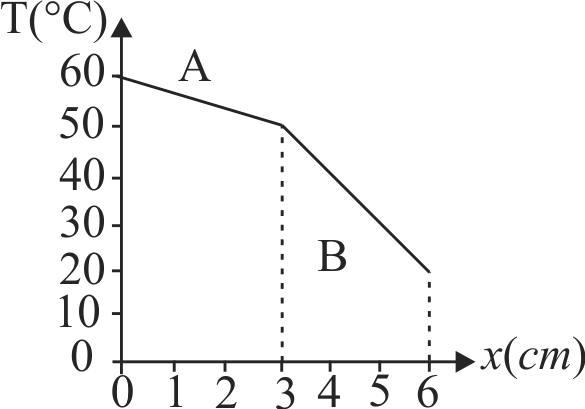366290
The specific heat capacity of a metal at low temperature \(\left( T \right)\) is given as
\(C_{p}\left(k H K^{-1} k^{-1}\right)=32\left(\dfrac{T}{400}\right)^{3}\)
A 100 gram vessel of this metal is to be cooled from \(20^\circ K\,{\rm{to}}\,4^\circ K\) by a special refrigerator operating at room temperature \(\left( {27^\circ C} \right)\). The amount of work required to cool the vessel is
366292
A lead bullet at \(277^\circ C\) just melts when stopped by an obstacle. Assuming that \(25 \%\) of heat is absorbed by the obstacle, the minimum velocity the bullet should possess at the time of striking is
(Take \(M.P.\) of lead \( = 327^\circ C,\) \({c_{lead{\rm{ }}}} = 0.03\,{\rm{cal/}}g^\circ C,\) latent heat of fusion of lead \( = 5.5\,{\rm{cal/}}g,1\,{\rm{cal}} = 4.20\;J\))
366290
The specific heat capacity of a metal at low temperature \(\left( T \right)\) is given as
\(C_{p}\left(k H K^{-1} k^{-1}\right)=32\left(\dfrac{T}{400}\right)^{3}\)
A 100 gram vessel of this metal is to be cooled from \(20^\circ K\,{\rm{to}}\,4^\circ K\) by a special refrigerator operating at room temperature \(\left( {27^\circ C} \right)\). The amount of work required to cool the vessel is
366292
A lead bullet at \(277^\circ C\) just melts when stopped by an obstacle. Assuming that \(25 \%\) of heat is absorbed by the obstacle, the minimum velocity the bullet should possess at the time of striking is
(Take \(M.P.\) of lead \( = 327^\circ C,\) \({c_{lead{\rm{ }}}} = 0.03\,{\rm{cal/}}g^\circ C,\) latent heat of fusion of lead \( = 5.5\,{\rm{cal/}}g,1\,{\rm{cal}} = 4.20\;J\))
366290
The specific heat capacity of a metal at low temperature \(\left( T \right)\) is given as
\(C_{p}\left(k H K^{-1} k^{-1}\right)=32\left(\dfrac{T}{400}\right)^{3}\)
A 100 gram vessel of this metal is to be cooled from \(20^\circ K\,{\rm{to}}\,4^\circ K\) by a special refrigerator operating at room temperature \(\left( {27^\circ C} \right)\). The amount of work required to cool the vessel is
366292
A lead bullet at \(277^\circ C\) just melts when stopped by an obstacle. Assuming that \(25 \%\) of heat is absorbed by the obstacle, the minimum velocity the bullet should possess at the time of striking is
(Take \(M.P.\) of lead \( = 327^\circ C,\) \({c_{lead{\rm{ }}}} = 0.03\,{\rm{cal/}}g^\circ C,\) latent heat of fusion of lead \( = 5.5\,{\rm{cal/}}g,1\,{\rm{cal}} = 4.20\;J\))
366290
The specific heat capacity of a metal at low temperature \(\left( T \right)\) is given as
\(C_{p}\left(k H K^{-1} k^{-1}\right)=32\left(\dfrac{T}{400}\right)^{3}\)
A 100 gram vessel of this metal is to be cooled from \(20^\circ K\,{\rm{to}}\,4^\circ K\) by a special refrigerator operating at room temperature \(\left( {27^\circ C} \right)\). The amount of work required to cool the vessel is
366292
A lead bullet at \(277^\circ C\) just melts when stopped by an obstacle. Assuming that \(25 \%\) of heat is absorbed by the obstacle, the minimum velocity the bullet should possess at the time of striking is
(Take \(M.P.\) of lead \( = 327^\circ C,\) \({c_{lead{\rm{ }}}} = 0.03\,{\rm{cal/}}g^\circ C,\) latent heat of fusion of lead \( = 5.5\,{\rm{cal/}}g,1\,{\rm{cal}} = 4.20\;J\))

